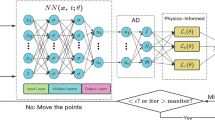Abstract
The Runge-Kutta discontinuous Galerkin method (RKDG method) is widely used nowadays. The RKDG method is characterized by a high-order accurate solution. As is well known, for ensuring the monotonic solution by this method, it is necessary to use slope limiters. In particular, it is necessary when the solution contains strong discontinuities. However, the application of limiters can negatively affect the accuracy of the solution. In this paper a way of saving the order of accuracy of the solution and ensuring its monotony is investigated.
Similar content being viewed by others

References
B. Cockburn, “An Introduction to the Discontinuous Galerkin method for convection-dominated problems,” Advanced Numerical Approximation of Nonlinear Hyperbolic Equations, Lect. Notes Math. 1697, 151 (Springer Berlin Heidelberg, 1998).
V. V. Rusanov, “The calculation of the interaction of non-stationary shock waves with barriers,” Zh. Vychisl. Mat. Mat. Fiz. 1, 267–279 (1961).
P. D. Lax, “Weak solutions of nonlinear hyperbolic equations and their numerical computation,” Commun. Pur. Appl. Math. 7(1), 159–193 (1954).
M. P. Galanin, E. B. Savenkov, and S. A. Tokareva, Application of Discontinuous Galerkin Method for Numerical Solution of Quasi-Linear Transfer Equation (Keldysh Institute of Applied Mathematics, Russian Academy of Sciences, Moscow, 2005) Preprint No. 105 [in Russian].
L. Krivodonova, “Limiters for high-order discontinuous Galerkin methods,” J. Comput. Phys. 226, 879 (2007).
L. D. Landau and E. M. Lifshitz, Fluid Dynamics, Course of Theoretical Physisc, Vol. 6 (Fizmatlit, Moscow, 2001) [in Russian].
G.B. Whitham, Linear and Nonlinear Waves (Wiley, New York, 1974).
M. E. Ladonkina, O. A. Neklyudova, and V. F. Tishkin, Studying the Effect of Limiter on the Order of Accuracy of a Solution Obtained by the Discontinuous Galerkin Method (Keldysh Institute of Applied Mathematics, Russian Academy of Sciences, Moscow, 2012) Preprint No. 34 [in Russian].
M. E. Ladonkina, O. A. Neklyudova, and V. F. Tishkin, “Impact of different limiting functions on the order of solution obtained by RKDG,” Math. Models Comput. Simul. 5, 346–349 (2013).
M. E. Ladonkina, O. A. Neklyudova, and V. F. Tishkin, Limiter of Increased Accuracy Order for Discontinuous Gelerkin Method on Triangular Grids (Keldysh Institute of Applied Mathematics, Russian Academy of Sciences, Moscow, 2013) Preprint No. 53 [in Russian].
C.-W. Shu and S. Osher, “Efficient implementation of essentially non-oscillatory shock-capturing schemes II,” J. Comput. Phys. 83, 32 (1989).
Author information
Authors and Affiliations
Corresponding author
Additional information
Original Russian Text © M.E. Ladonkina, O.A. Neklyudova, V.F. Tishkin, 2014, published in Matematicheskoe Modelirovanie, 2014, Vol. 26, No. 1, pp. 17–32.
Rights and permissions
About this article
Cite this article
Ladonkina, M.E., Neklyudova, O.A. & Tishkin, V.F. Application of the RKDG method for gas dynamics problems. Math Models Comput Simul 6, 397–407 (2014). https://doi.org/10.1134/S207004821404005X
Received:
Published:
Issue Date:
DOI: https://doi.org/10.1134/S207004821404005X



